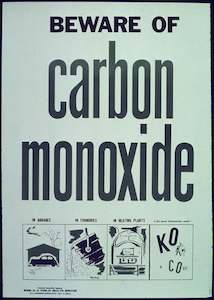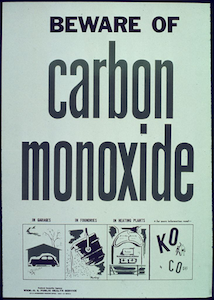 We all think we understand CO poisoning, yet every year thousands of people die from it. Remember, it’s about more than replacing batteries, it’s about knowing the risk.
We all think we understand CO poisoning, yet every year thousands of people die from it. Remember, it’s about more than replacing batteries, it’s about knowing the risk.
Science: Carbon monoxide (CO) is a colorless, invisible, odorless and tasteless gas that is produced when fossil fuels such as natural gas, propane, kerosene, coal or wood, etc. are burned. It is the most common form of accidental poisoning in the US, and causes between 10-15,000 cases of poisoning and 300-400 fatalities every year.
How: CO can escape from faulty furnaces or room heaters, or through rusty or cracked vents. Basically, carbon monoxide inhibits the blood’s capacity to carry oxygen because the hemoglobin in our blood cells has a preference for carbon monoxide. CO can kill a person very quickly when high levels are present.
Signs: soot marks near a fireplace; the lack of a draft in chimneys; condensation/wetness on the windows and walls of furnace rooms; or rust on appliance jackets or vent pipes.
Symptoms: Low-level exposure can result in flu-like symptoms such as headaches, dizziness, fatigue, nausea, vomiting and disorientation and it is believed that as many as one fourth of poisoning cases are misdiagnosed as flu. Everyone is at risk, but infants, children, pregnant women, seniors and people with respiratory ailments are particularly vulnerable.
Detection: Carbon monoxide cannot be detected without a reliable detector. As CO is emitted by chimneys, fireplaces, gas ovens, space heaters, auto exhausts, barbeque grills, gas dryers, furnaces and water heaters, it is as well to check these appliances regularly. Remember, new homes are constructed to seal in as much heat as possible which limits free air exchange and can encourage CO build up.
Precautions:
Check and clean your chimney, fireplace and venting pipes annually.
Have a qualified technician check your furnace’s electrical and mechanical components, such as thermostat controls and automatic safety devices.
Check for blockages such as birds’ nests and debris, which may prevent toxic gases from escaping.
Make sure flues and flue connectors are tight and secure and that there are no signs of rust or cracks that could allow toxic gases to enter your home.
Install carbon monoxide detectors. (Underwriters Laboratories (UL) standard 2034 fitted to the manufacturer’s specifications.) There are hardwired and battery types available. The battery type can be placed wherever it is needed and operates even when the power is out for a long time. At least one per floor.
Don’t bring the gas grill or gas powered generator inside, or sit in a closed room with a space heater.
Keep all areas well ventilated.

